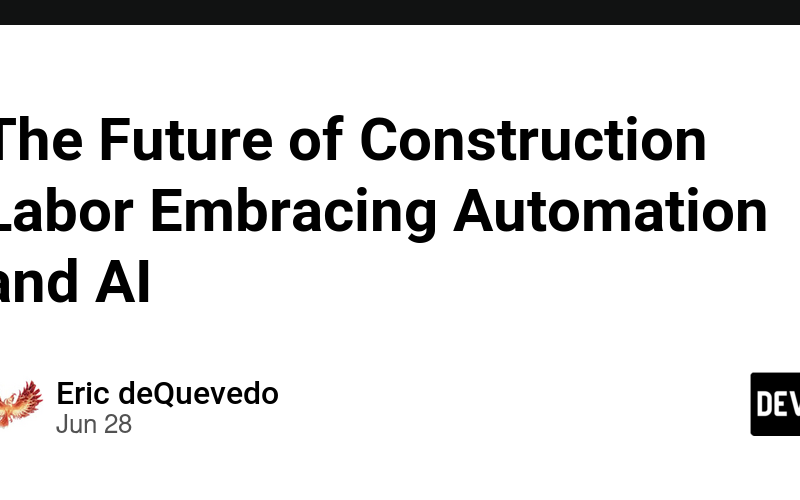The construction industry is on the brink of a transformative era, driven by the rapid advancements in automation and Artificial Intelligence (AI). Traditionally notorious for its labor-intensive processes and susceptibility to delays and errors, construction is now being reimagined through the lens of technological innovation. Let’s dive into how automation and AI are reshaping construction, enhancing efficiency, safety, and sustainability at unprecedented scales.
The Automation Revolution
Robotics on the Rise
Robotic systems are no longer confined to manufacturing plants; they are breaking ground in construction sites. Advanced robotics can perform a myriad of tasks such as bricklaying, welding, and even 3D printing of entire structures. Take the example of SAM100 (Semi-Automated Mason), a bricklaying robot that can lay up to 3,000 bricks a day—dramatically outpacing human capabilities while maintaining superior precision.
Autonomous Vehicles
Construction sites are abuzz with autonomous equipment and vehicles. Autonomous haul trucks, excavators, and bulldozers are now a common sight, seamlessly navigating through the intricate landscapes of construction zones. Equipped with GPS, LiDAR, and advanced sensing technologies, these machines ensure optimal efficiency and safety, reducing human errors and operational costs.
Prefabrication and Modular Construction
Automation extends beyond the onsite hustle. Modular construction and prefabrication are gaining traction, where building components are produced in a controlled factory environment and then assembled onsite. This method significantly cuts down waste, shortens project timelines, and ensures higher quality control. Companies like Katerra are leading this change, proving that entire homes can be assembled in mere days!
The AI Infusion
Predictive Analytics and Project Management
AI-powered predictive analytics are game-changers in project management. By analyzing vast datasets from past projects, AI can forecast future trends, identify potential risks, and optimize scheduling. Systems like BuildOS offer real-time project insights, allowing managers to make data-driven decisions, reduce downtime, and stay within budget.
Design Optimization
AI isn’t just streamlining construction processes; it’s revolutionizing the way we design buildings. Generative design algorithms, like those in Autodesk’s BIM 360, enable architects and engineers to input design goals and constraints, with the system generating a multitude of design alternatives. This technology not only fosters creativity but also ensures the final design is cost-effective and sustainable.
Enhanced Safety Protocols
Safety is paramount in construction, and AI is making strides in this area too. Wearable sensors, paired with AI analytics, can monitor workers’ health metrics and environment conditions in real-time. Drones equipped with AI can conduct site inspections, identifying potential hazards before they become problematic. The Smartvid.io platform, for instance, uses AI-powered analysis of video footage to flag safety violations and improve site safety protocols.
The Road Ahead: Challenges and Opportunities
Skill Development and Workforce Evolution
As automation and AI become integral to construction, the demand for tech-savvy professionals will surge. This shift presents a unique challenge and opportunity: reskilling the existing workforce to manage, operate, and maintain advanced machinery and AI systems. Training programs focusing on these new technologies will be critical in ensuring a smooth transition.
Ethical and Economical Considerations
While the benefits are evident, the rise of automation and AI also brings ethical and economic questions to the forefront. There’s a prevailing concern about job displacement; however, history shows us that technological progress often creates new roles even as it renders others obsolete. A balanced approach, keeping human workers at the center of this transformation, is essential.
Sustainable Construction
Automation and AI are also at the heart of sustainable construction practices. AI can optimize the use of materials, reducing waste and promoting recycling. Robotics and autonomous systems enable precise execution, minimizing environmental impact. Green construction is no longer a buzzword—it’s becoming a reality, thanks to these tech advancements.
Conclusion
The future of construction labor is not just about replacing humans with machines; it’s about augmenting human capabilities with cutting-edge technology. Automation and AI are driving this change, promising a future where construction is smarter, safer, and more sustainable. As we embrace these innovations, the possibilities are endless, and the skyline of tomorrow will be a testament to this exciting evolution. Let’s build the future!
Feel free to share your thoughts and insights in the comments below. How do you see automation and AI shaping the construction industry in your region? What challenges and opportunities lie ahead? The conversation is just getting started!
Source link
lol

